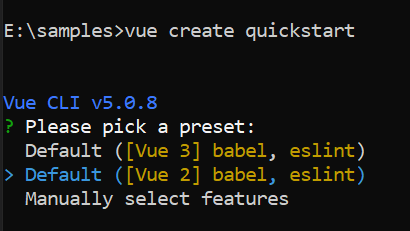Getting Started with the Vue OTP Input component in Vue 2
25 Apr 20254 minutes to read
This section explains how to create a simple OTP Input component and configure its available functionalities in Vue 2 project using Vue-CLI and integrating the Syncfusion® Vue OTP Input component using the Composition API / Options API.
Dependencies
The list of dependencies required to use the OTP Input component in your application is given as follows:
|-- @syncfusion/ej2-vue-inputs
|-- @syncfusion/ej2-vue-base
|-- @syncfusion/ej2-base
|-- @syncfusion/ej2-inputsSetting up the Vue 2 project
To generate a Vue 2 project using Vue-CLI, use the vue create command. Follow these steps to install Vue CLI and create a new project:
npm install -g @vue/cli
vue create quickstart
cd quickstart
npm run serveor
yarn global add @vue/cli
vue create quickstart
cd quickstart
yarn run serveWhen creating a new project, choose the option Default ([Vue 2] babel, eslint) from the menu.

Once the quickstart project is set up with default settings, proceed to add Syncfusion® components to the project.
Add Syncfusion® Vue packages
Syncfusion® packages are available at npmjs.com. To use Vue components, install the required npm package.
This article uses the Vue OTP Input component as an example. Install the @syncfusion/ej2-vue-inputs package by running the following command:
npm install @syncfusion/ej2-vue-inputs --saveor
yarn add @syncfusion/ej2-vue-inputsImport Syncfusion® CSS styles
You can import themes for the Syncfusion® Vue component in various ways, such as using CSS or SASS styles from npm packages, CDN, CRG and Theme Studio. Refer to themes topic to know more about built-in themes and different ways to refer to themes in a Vue project.
In this article, the Material theme is applied using CSS styles, which are available in installed packages. The necessary Material CSS styles for the OTP Input component and its dependents were imported into the <style> section of src/App.vue file.
<style>
@import '../node_modules/@syncfusion/ej2-base/styles/material.css';
@import '../node_modules/@syncfusion/ej2-inputs/styles/material.css';
</style>Add Syncfusion® Vue component
Follow the below steps to add the Vue OTP Input component using Composition API or Options API:
1. First, import and register the OTP Input component in the script section of the src/App.vue file. If you are using the Composition API, you should add the setup attribute to the script tag to indicate that Vue will be using the Composition API.
<script setup>
import { OtpInputComponent as EjsOtpinput } from "@syncfusion/ej2-vue-inputs";
</script><script>
import { OtpInputComponent } from "@syncfusion/ej2-vue-inputs";
export default {
components: {
'ejs-otpinput': OtpInputComponent
}
}
</script>2. In the template section define the OTP Input component.
<template>
<div id='container'>
<ejs-otpinput id="otpinput"></ejs-otpinput>
</div>
</template>Here is the summarized code for the above steps in the src/App.vue file:
<template>
<div id='container'>
<ejs-otpinput id="otpinput"></ejs-otpinput>
</div>
</template>
<script setup>
import { OtpInputComponent as EjsOtpinput } from "@syncfusion/ej2-vue-inputs";
import { enableRipple } from '@syncfusion/ej2-base';
enableRipple(true);
</script>
<style>
@import '../node_modules/@syncfusion/ej2-base/styles/material.css';
@import '../node_modules/@syncfusion/ej2-inputs/styles/material.css';
#container {
margin-top: 30px;
padding: 30px;
}
</style><template>
<div id='container'>
<ejs-otpinput id="otpinput"></ejs-otpinput>
</div>
</template>
<script>
import { OtpInputComponent } from "@syncfusion/ej2-vue-inputs";
import { enableRipple } from '@syncfusion/ej2-base';
enableRipple(true);
export default {
components: {
'ejs-otpinput': OtpInputComponent
}
}
</script>
<style>
@import '../node_modules/@syncfusion/ej2-base/styles/material.css';
@import '../node_modules/@syncfusion/ej2-inputs/styles/material.css';
#container {
margin-top: 30px;
padding: 30px;
}
</style>Run the project
To run the project, use the following command:
npm run serveor
yarn run serve